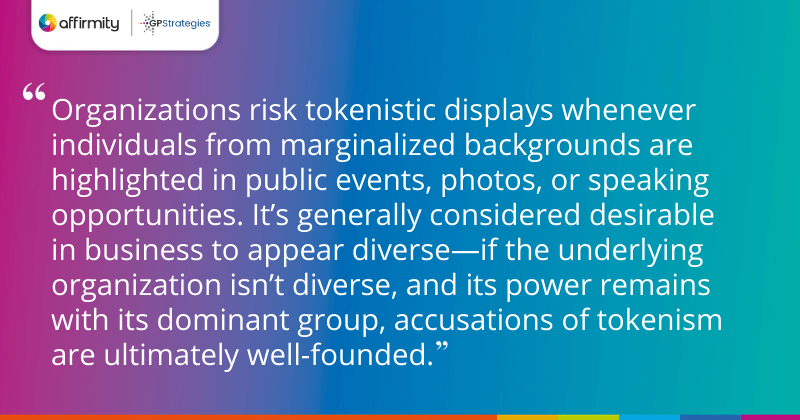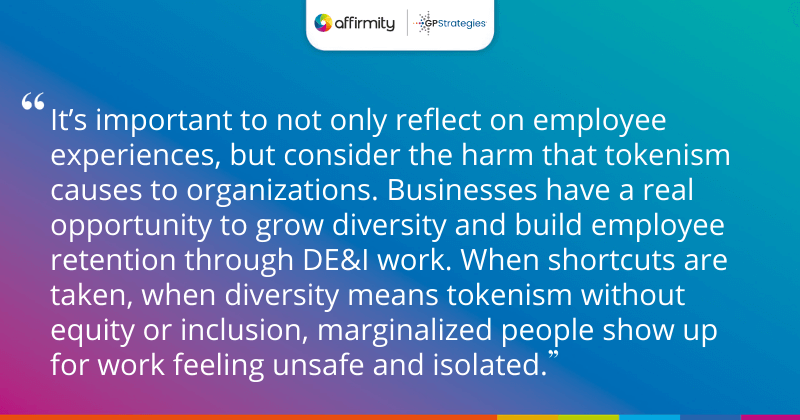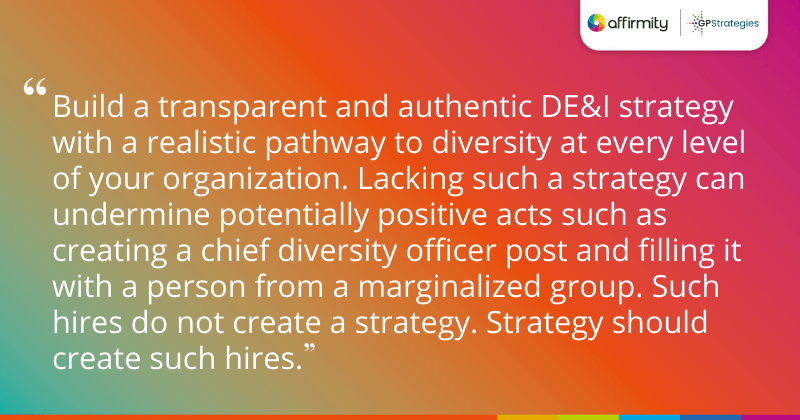Organizations can undermine their diversity, equity, and inclusion efforts when marketing and key hiring decisions veer into tokenism. In this article, Taniya Sonko from GP Strategies (an Affirmity inclusion training partner) explores the line between genuinely diverse best practices and tokenism, offering five key tactics that will help you affect lasting change.
When strategies for improving an organization’s diversity are initially considered, one of the first entrenched ideas that must be challenged is having an entirely homogenous workforce. Then, once a company has begun assembling a diverse pool of talent, the focus shifts towards inclusion, and counteracting the isolation that many marginalized employees may naturally feel moving into a space with an existing dominant culture.
Tokenism is one significant danger of this complex renegotiation of diversity and inclusion—it’s the mismatch between an organization’s performative effort and its actual record on inclusive behavior. Organizations risk tokenistic displays whenever individuals from marginalized backgrounds are highlighted in public events, photos, or speaking opportunities. It’s generally considered desirable in business to appear diverse—if the underlying organization isn’t diverse, and its power remains with its dominant group, accusations of tokenism are ultimately well-founded.
When Is it Tokenism? Why It’s Important to Recognize How Your Employees Actually Feel
“I’m the only one in the room” is a familiar refrain from marginalized employees—and being conscious of this fact can have a significant impact on how an individual approaches their work and the opportunities that come their way. The feeling manifests in extra pressure to perform, or a desire to avoid perpetuating negative stereotypes—whether the need to do either is real or imagined, the effect is the same.

Now imagine a Black employee is approached to be photographed for the organization’s new website, or to speak at an upcoming conference. They will likely be hesitant to turn down either opportunity—perhaps because they’re worried that their concerns will be seen as them being stereotypically “difficult”. It’s easy for people in this position to feel like they’re perceived as a monolith—the sole representative of a wider group.
Tokenization is rarely a boon. Anyone pushed into the position has a right to feel simultaneously overexposed and undervalued, and it can be exhausting to carry the burden of representing your group in simple day-to-day interactions. Doing the same publicly or to the C-suite can only intensify that feeling.
ANOTHER KEY ISSUE IN DE&I | ‘5 Ways Organizations Can Reduce the Impact of the Imposter Phenomenon’
The Real Harm of Tokenism

If an employee feels like they’re only there for your diversity scorecard, their confidence and ability to do their job will be impacted, and resentment will inevitably grow. They may also feel that there’s little room for psychological safety—after all, every time they’re cornered into an “opportunity”, they must weigh up whether to play along or push back.
It’s important to not only reflect on employee experiences, but consider the harm that tokenism causes to organizations. Businesses have a real opportunity to grow diversity and build employee retention through DE&I work. When shortcuts are taken, when diversity means tokenism without equity or inclusion, marginalized people show up for work feeling unsafe and isolated.
Tokenism is an issue in the C-suite as well. In the last couple of years, we’ve increasingly seen organizations creating a new role, the chief diversity officer, ostensibly to rectify their homogenous C-suite. The potential of this role is positive—giving a person real power to steer and deliver DE&I in the organization is important. However, if this work isn’t also leading to changes in other C-level roles, the role itself can be something of a tokenistic outpost. In a post-George Floyd world, some companies have placed Black executives in these positions, giving them unclear responsibilities and short-term timelines. This needs to stop.
MORE FROM THE BLOG | ‘4 Areas You May Not Have Considered When Mitigating Hiring Bias’
Avoiding Tokenism: 5 Key Steps

An organization’s actions can appear tokenistic when its DE&I effort is itself tokenistic. Establishing a robust DE&I strategy and rethinking how you approach marketing, hiring, measurement, learning, and every other aspect of your business will help you avoid tokenism. Follow these five key steps to get started:
- Be more introspective about who is in your organization’s promotional photography, whether a given project uses a stock image library or creates new assets by using people from within the business. Stock images should reflect your workforce and not give a false impression of your demographics. Similarly, you should take care to not repeatedly approach the same narrow range of employees from minority backgrounds. In both cases, it’s important not to create a false impression of who you currently are as a business.
- Build a transparent and authentic DE&I strategy with a realistic pathway to diversity at every level of your organization. Lacking such a strategy can undermine potentially positive acts such as creating a chief diversity officer post and filling it with a person from a marginalized group. Such hires do not create a strategy. Strategy should create such hires.
- Measure the impact of diversity—don’t just quantify the people involved. You want to know not just how many people in your organization have a certain background, but where they are in the business. And you want to know not only what percentage of your board are from a certain background, but whether that presence actually results in their voices being heard and their ideas being acted on.
- Maintain direct channels with marginalized employees in order to cultivate trust and preserve a safe space. Your organization could encourage listening projects and the L&D function shouldn’t simply focus on “do and don’t” training. Equip your people to call out less-than-inclusive behavior. These inward-focused measures are important, in contrast to more tokenistic actions, where the motivation usually comes from outside.
- Clearly establish inclusion as everyone’s responsibility—clear messaging must run throughout the organization. Leaders must lead by example, and all employees should receive D&I training.
LEARN ABOUT MEASURING DE&I | ‘5 Steps for Measuring the “Unmeasurable” and Creating a Data-Led Diversity and Inclusion Plan’
If you would like to discuss how to become a more diverse, inclusive, and equitable organization, please contact us today.
A version of this article originally appeared in Training Magazine.
 About the Author
About the Author
Taniya Sonko is a Global Account Director for DE&I at GP Strategies. She is an equity, diversity and inclusion professional with experience in consultancy and training in both the public and private sectors. Her passion for tackling social injustice has led her to work with organizations ranging from grassroots community collectives to intergovernmental bodies such as the United Nations, and large corporations.
